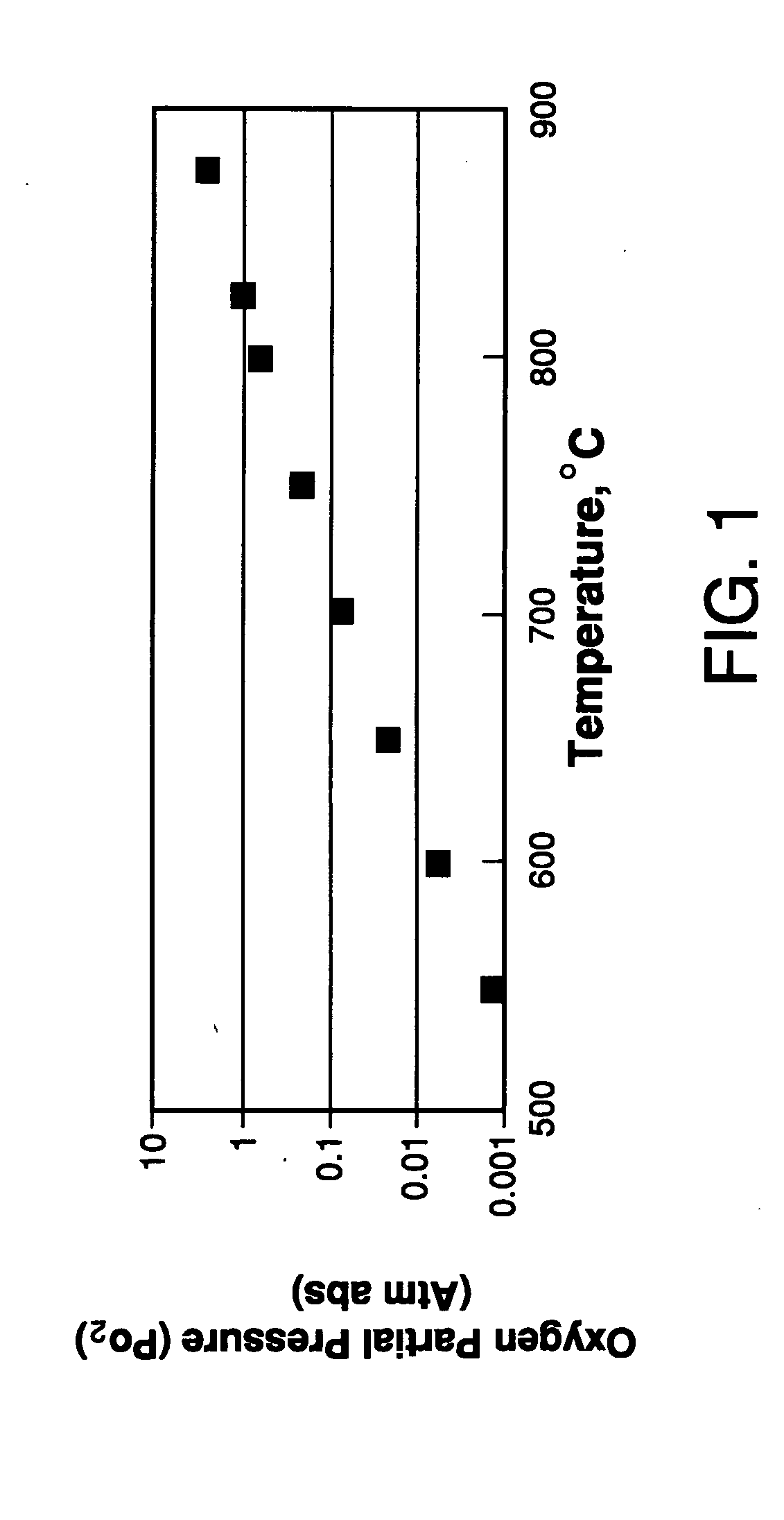Controlled heating and cooling of mixed conducting metal oxide materials
- Summary
- Abstract
- Description
- Claims
- Application Information
AI Technical Summary
Benefits of technology
Problems solved by technology
Method used
Image
Examples
example 1
Preparation of Test Samples
[0117] Dense bars were prepared by uniaxially pressing powder of La0.4Sr0.6CoO3-δ, sintering at 1250° C. for 4 hours, and cooling to room temperature. The bars were machined to dimensions of 4 mm wide by 2.2 mm thick and 51.3 mm long. The bars then were annealed in air to remove any surfaces stresses caused by machining by heating to 1100° C. at 1° C. / min, cooling to 600° C. at 1° C. / min, and cooling to room temperature at 0.5° C. / min.
example 2
Cooling in Air
[0118] Six bars prepared in the manner of Example 1 were heated in air at 2° C. / min to 850° C., and cooled at 1° C. / min to ambient temperature. The oxygen partial pressure was maintained at 0.209 atm by flowing a small amount of air into the furnace. After cooling to room temperature, the flexural strength of the bars was measured at room temperature in a four point bending apparatus. Exemplary techniques for conducting this testing can be found in ASTM C1161-94. The average strength of the 6 bars was 39.8 MPa with a standard deviation of 12.6 MPa.
example 3
Isocompositional Cooling
[0119] Six bars prepared in the manner of Example 1 were heated inside a retort in air at 2° C. / min to 850° C., and cooled 1° C. / min to room temperature while controlling the oxygen partial pressure in the retort. For the temperature range of 850° C. to 600° C., the oxygen partial pressure was maintained at 0.209 atm by flowing a small amount of air into the retort. For the temperature range of 600° C. to room temperature, the oxygen partial pressure inside the retort was controlled to maintain a constant oxygen stoichiometry in the ceramic bars. The variation of oxygen partial pressure as a function of temperature, to maintain a constant equilibrium vacancy concentration, xV(T*,0.21), is given in the equation below: ln(PO2)=EOx-4g(ɛt)(6xv(T*,0.21)-x)-TSOx-2RT ln(xv(T*,0.21)1-xv(T*,0.21))-μO20(T)RT
where xV(T*,0.21) represents the isocompositional oxygen vacancy concentration to be held constant at isocompositional temperature, T*, and PO2 of 0....
PUM
| Property | Measurement | Unit |
|---|---|---|
| Temperature | aaaaa | aaaaa |
| Partial pressure | aaaaa | aaaaa |
| Pressure | aaaaa | aaaaa |
Abstract
Description
Claims
Application Information
 Login to View More
Login to View More - R&D
- Intellectual Property
- Life Sciences
- Materials
- Tech Scout
- Unparalleled Data Quality
- Higher Quality Content
- 60% Fewer Hallucinations
Browse by: Latest US Patents, China's latest patents, Technical Efficacy Thesaurus, Application Domain, Technology Topic, Popular Technical Reports.
© 2025 PatSnap. All rights reserved.Legal|Privacy policy|Modern Slavery Act Transparency Statement|Sitemap|About US| Contact US: help@patsnap.com



